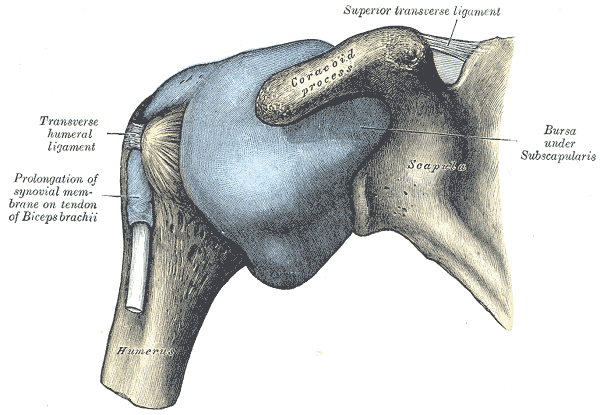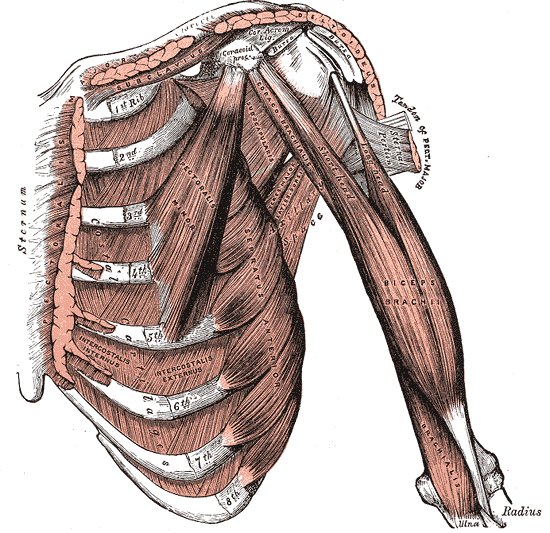Coracoid process
Template:Infobox Bone Editor-In-Chief: C. Michael Gibson, M.S., M.D. [1]
}
The coracoid process is a small hook-like structure that comes off the scapula to point forward.
Attachments
It is the site of attachment for several structures:
- The pectoralis minor muscle - to 3rd to 5th ribs.
- The short head of biceps brachii muscle - to Radial tuberosity.
- The coracobrachialis muscle - to medial humerus.
- The coracoclavicular ligament - to the clavicle. (It is formed by the conoid ligament and trapezoid ligament.)
- The coracoacromial ligament - to the acromion
Structure
The coracoid process is a thick curved process attached by a broad base to the upper part of the neck of the scapula; it runs at first upward and medialward; then, becoming smaller, it changes its direction, and projects forward and lateralward.
The ascending portion, flattened from before backward, presents in front a smooth concave surface, across which the Subscapularis passes.
The horizontal portion is flattened from above downward; its upper surface is convex and irregular, and gives attachment to the Pectoralis minor; its under surface is smooth; its medial and lateral borders are rough; the former gives attachment to the Pectoralis minor and the latter to the coracoacromial ligament; the apex is embraced by the conjoined tendon of origin of the Coracobrachialis and short head of the Biceps brachii and gives attachment to the coracoclavicular fascia.
On the medial part of the root of the coracoid process is a rough impression for the attachment of the conoid ligament; and running from it obliquely forward and lateralward, on to the upper surface of the horizontal portion, is an elevated ridge for the attachment of the trapezoid ligament.
Clinical relevance
The coracoid process is palpable just below the lateral end of the clavicle (collar bone). It is otherwise known as the "Surgeon's Lighthouse" because it serves as a landmark to avoid neurovascular damage. Major neurovascular structures enter the upper limb medial to the coracoid process so surgical approaches to the shoulder region always takes place lateral to the coracoid process.
In other animals
In birds and reptiles, the coracoid is a separate bone.
Etymology
Coracoid in itself means "like a raven's beak", with reference to its shape. (Greek "Korax" = Raven)
Additional images
-
Capsule of shoulder-joint (distended). Anterior aspect.
-
Glenoid fossa of right side.
-
Deep muscles of the chest and front of the arm, with the boundaries of the axilla.


